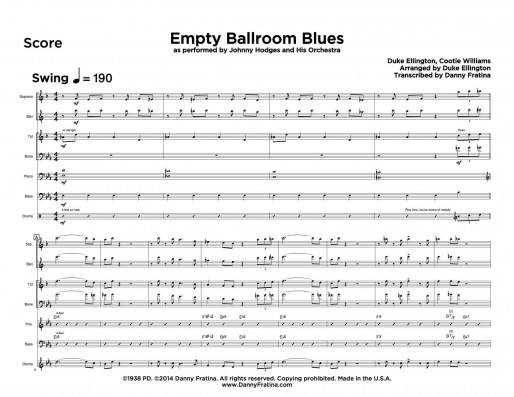-
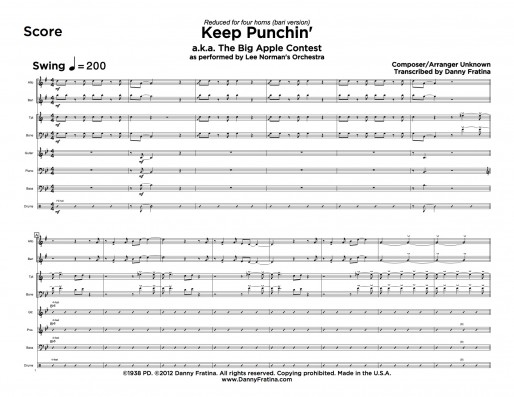 Also known as "The Big Apple Contest," Keep Punchin' is a swing dancer staple and a must-have for any band that will ever play for swing dancers! After the famous simple intro a brass trio work plays off of a sax riff, and from there on it's simple burnin' riffs all the way home, with lots of great brass plunger work.
Also known as "The Big Apple Contest," Keep Punchin' is a swing dancer staple and a must-have for any band that will ever play for swing dancers! After the famous simple intro a brass trio work plays off of a sax riff, and from there on it's simple burnin' riffs all the way home, with lots of great brass plunger work.Instrumentation Ellington 7-Piece Style Swing Era Level 2 TEMPO  = 200
= 200Trumpet
Range
-
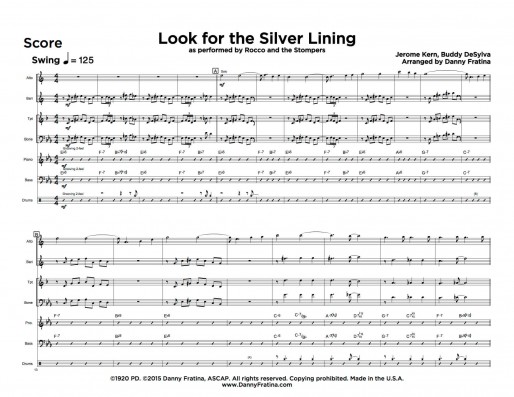 This alto feature is a perfect tempo for new dancers and has some very cool background lines from the trio of trumpet, trombone, and bari sax. Let your alto play out a la Johnny Hodges and have your trio dig in with some conviction and this chart will swing hard.
This alto feature is a perfect tempo for new dancers and has some very cool background lines from the trio of trumpet, trombone, and bari sax. Let your alto play out a la Johnny Hodges and have your trio dig in with some conviction and this chart will swing hard.Instrumentation Ellington 7-Piece Style Swing Era Level 2 TEMPO  = 125
= 125Trumpet
Range
-
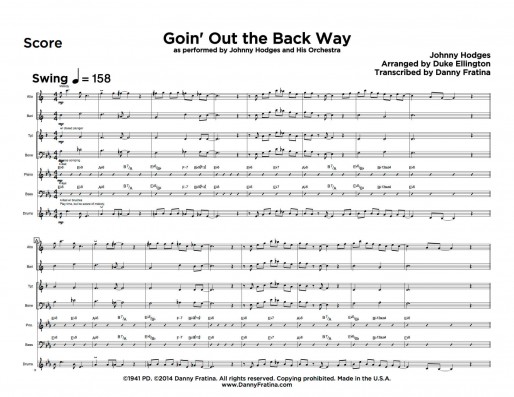 A well-rounded starter chart (especially for younger bands), Goin' Out the Back Way features a nice melody with every instrument in the comfortable zones of their ranges, simple backgrounds, cool chord changes, and a medium tempo. A couple of instruments that don't get too many solos have their space here as well. Slightly tricky for a level 1, but nothing crazy!
A well-rounded starter chart (especially for younger bands), Goin' Out the Back Way features a nice melody with every instrument in the comfortable zones of their ranges, simple backgrounds, cool chord changes, and a medium tempo. A couple of instruments that don't get too many solos have their space here as well. Slightly tricky for a level 1, but nothing crazy!Instrumentation Ellington 7-Piece Style Swing Era Level 1 TEMPO  = 155
= 155Trumpet
Range
-
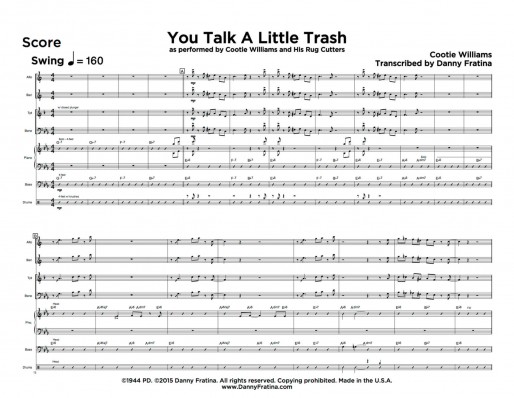 Aside from a little chromaticism on the bridge, You Talk a Little Trash is a solid level 1 swinger. Most of the melody is unison, the changes are simple, the tempo is an easy-going 160bpm, and the lines are timeless. Cootie Williams shows that you can do a lot with a little on this catchy chart.
Aside from a little chromaticism on the bridge, You Talk a Little Trash is a solid level 1 swinger. Most of the melody is unison, the changes are simple, the tempo is an easy-going 160bpm, and the lines are timeless. Cootie Williams shows that you can do a lot with a little on this catchy chart.Instrumentation Ellington 7-Piece Style Swing Era Level 1 TEMPO  = 160
= 160Trumpet
Range
-
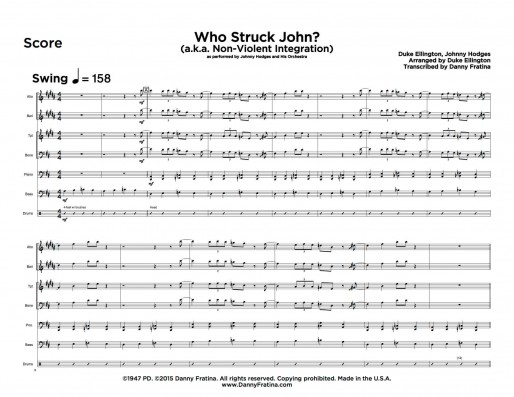 Also known as "Non-Violent Integration", Who Struck John? is a very simple but very cool head tune. This arrangement is unusual in its use of rock/metal style parallel fifths in the rhythm section, otherwise known in modern times as barre chords. This is a chart for jamming on a straight-ahead D Major blues, with solo space for nearly everyone.
Also known as "Non-Violent Integration", Who Struck John? is a very simple but very cool head tune. This arrangement is unusual in its use of rock/metal style parallel fifths in the rhythm section, otherwise known in modern times as barre chords. This is a chart for jamming on a straight-ahead D Major blues, with solo space for nearly everyone.Instrumentation Ellington 7-Piece Style Swing Era Level 1 TEMPO  = 160
= 160Trumpet
Range
-
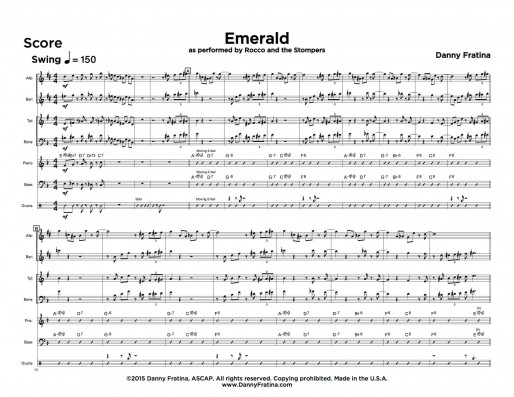 Emerald is a Rocco and the Stompers original that primarily features the alto sax with triad counterpoint a la Johnny Hodges and Duke Ellington. This is a fun an interesting chart considering how relatively easy it is, and it's always a hit with dancers!
Emerald is a Rocco and the Stompers original that primarily features the alto sax with triad counterpoint a la Johnny Hodges and Duke Ellington. This is a fun an interesting chart considering how relatively easy it is, and it's always a hit with dancers!Instrumentation Ellington 7-Piece Style Swing Era Level 2 TEMPO  = 150
= 150Trumpet
Range
-
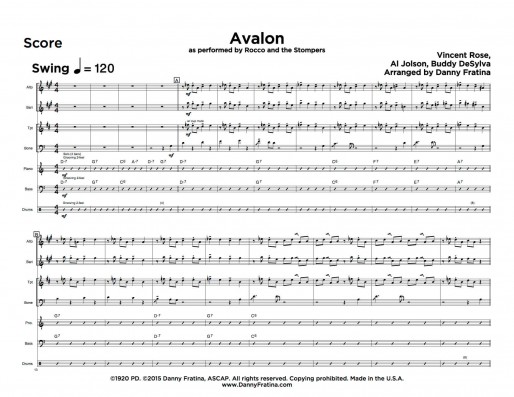 Coming out the same year as Prohibition, Avalon is one of the earliest jazz standards of the 20th century. Here, it's slowed down to a super slick beginner's dancing tempo featuring trombone on a staccato melody with a sassy background trio of cup mute trumpet, alto and bari sax almost taking over as a new melody over the bone.
Coming out the same year as Prohibition, Avalon is one of the earliest jazz standards of the 20th century. Here, it's slowed down to a super slick beginner's dancing tempo featuring trombone on a staccato melody with a sassy background trio of cup mute trumpet, alto and bari sax almost taking over as a new melody over the bone.Instrumentation Ellington 7-Piece Style Swing Era Level 3 TEMPO  = 120
= 120Trumpet
Range
-
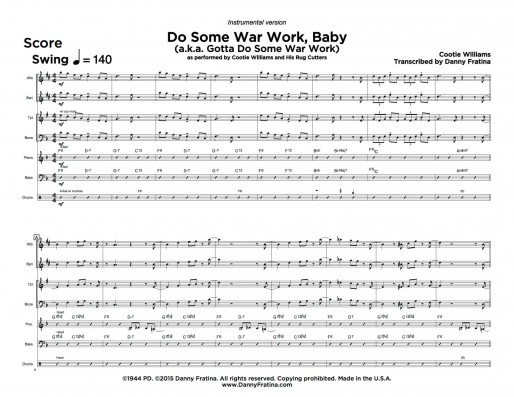 This Cootie Williams number is a great easy piece that still authentically swings hard. The original recording of Do Some War Work, Baby has a vocal chorus in the middle, but this transcription replaces it with a solo chorus for bari sax and alters the ending to make it fully instrumental. The vocal version can be found here.
This Cootie Williams number is a great easy piece that still authentically swings hard. The original recording of Do Some War Work, Baby has a vocal chorus in the middle, but this transcription replaces it with a solo chorus for bari sax and alters the ending to make it fully instrumental. The vocal version can be found here.Instrumentation Ellington 7-Piece Style Swing Era Level 1 TEMPO  = 140
= 140Trumpet
Range
-
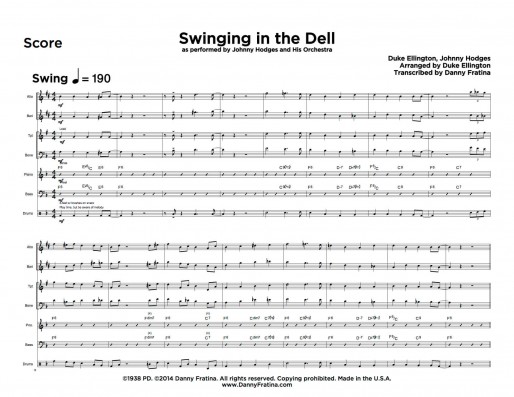 This upbeat Hodges/Ellington piece is a variation on the old nursery rhyme The Farmer in the Dell. After a statement of the melody, it's all solos with background riffs until the melody comes back at the end. Swinging in the Dell is a very simple solo vehicle that's great for getting dancers on the floor!
This upbeat Hodges/Ellington piece is a variation on the old nursery rhyme The Farmer in the Dell. After a statement of the melody, it's all solos with background riffs until the melody comes back at the end. Swinging in the Dell is a very simple solo vehicle that's great for getting dancers on the floor!Instrumentation Ellington 7-Piece Style Swing Era Level 2 TEMPO  = 190
= 190Trumpet
Range
-
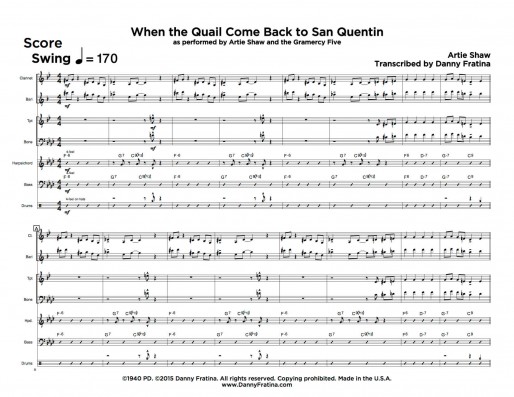 This hip Artie Shaw original features a little of everyone at the perfect dance tempo. Anecdotally, When the Quail Come Back to San Quentin was written in response to a music business insider's request for Shaw to play a sappy hit of the day. Shaw instead went live to air with this antithetical parody that seriously swings.
This hip Artie Shaw original features a little of everyone at the perfect dance tempo. Anecdotally, When the Quail Come Back to San Quentin was written in response to a music business insider's request for Shaw to play a sappy hit of the day. Shaw instead went live to air with this antithetical parody that seriously swings.Instrumentation Ellington 7-Piece Style Swing Era Level 3 TEMPO  = 170
= 170Trumpet
Range
-
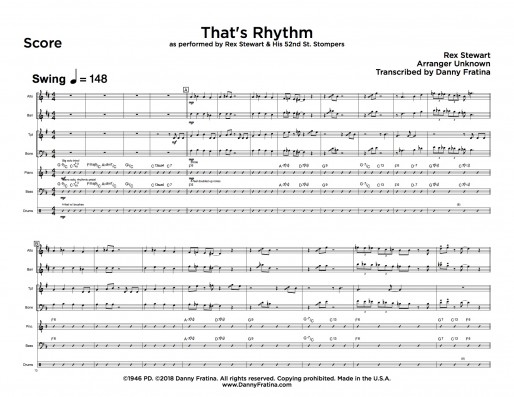 The unassumingly-titled "That's Rhythm" is a colorful tune that straddles the line between the swing era and the bebop era. Written by Ellington sideman Rex Stewart for his own shorter-lived 4-horn band, "Rhythm" features a punchy and memorable head and lots of solo space.
The unassumingly-titled "That's Rhythm" is a colorful tune that straddles the line between the swing era and the bebop era. Written by Ellington sideman Rex Stewart for his own shorter-lived 4-horn band, "Rhythm" features a punchy and memorable head and lots of solo space.Instrumentation Ellington 7-Piece Style Swing Era Level 2 TEMPO  = 148
= 148Trumpet
Range
-
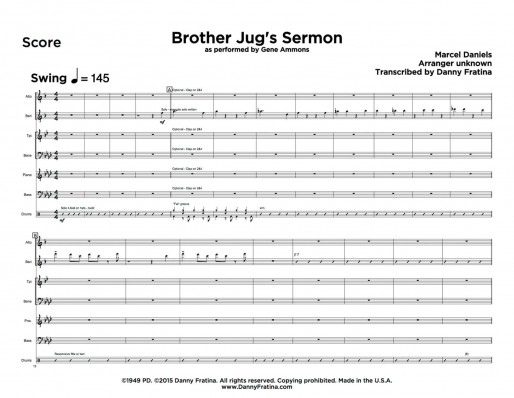 Gene Ammons preaches on in Brother Jug's Sermon, a soulfully grooving dance tune that now fully features bari sax. The horn backgrounds are simple enough--a couple of horn turns and a few suggested high notes in the bari make this an easy level 2. Swing music has never been so hip!
Gene Ammons preaches on in Brother Jug's Sermon, a soulfully grooving dance tune that now fully features bari sax. The horn backgrounds are simple enough--a couple of horn turns and a few suggested high notes in the bari make this an easy level 2. Swing music has never been so hip!Instrumentation Ellington 7-Piece Style Bebop, Swing Era Level 2 TEMPO  = 145
= 145Trumpet
Range
-
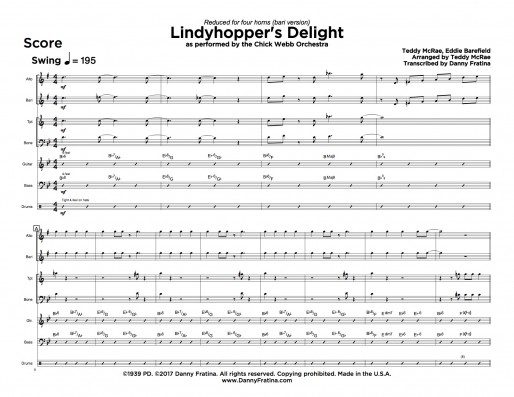 As standard dance repertoire, Lindyhopper's Delight is a catchy riff tune with a startlingly modern middle chorus that features some relatively harsh sax harmonies flanked by thickly-voiced plunger-supported brass hits. The final chorus is a raucous one, even though the brass are in full octave unison on a concert Bb! This is a great tune for any library though, and a good, albeit sometimes tricky, introduction to plungers for younger brass players.
As standard dance repertoire, Lindyhopper's Delight is a catchy riff tune with a startlingly modern middle chorus that features some relatively harsh sax harmonies flanked by thickly-voiced plunger-supported brass hits. The final chorus is a raucous one, even though the brass are in full octave unison on a concert Bb! This is a great tune for any library though, and a good, albeit sometimes tricky, introduction to plungers for younger brass players.Instrumentation Ellington 7-Piece Style Swing Era Level 2 TEMPO  = 195
= 195Trumpet
Range
-
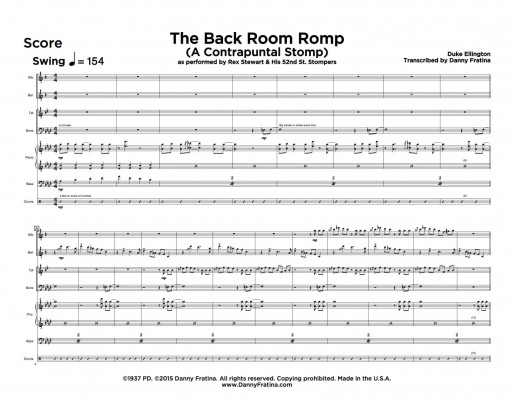 Back Room Romp is basically a simple blues in Ab, but there is a twist: the head is a series of building independent lines, thus a "Contrapuntal Stomp." Every horn player gets a solo chorus. The lead trumpet part is a bit of a blow, but this was written for longtime Ellington sideman, trumpeter Rex Stewart, who had the chops to play all day.
Back Room Romp is basically a simple blues in Ab, but there is a twist: the head is a series of building independent lines, thus a "Contrapuntal Stomp." Every horn player gets a solo chorus. The lead trumpet part is a bit of a blow, but this was written for longtime Ellington sideman, trumpeter Rex Stewart, who had the chops to play all day.Instrumentation Ellington 7-Piece Style Swing Era Level 3 TEMPO  = 154
= 154Trumpet
Range
-
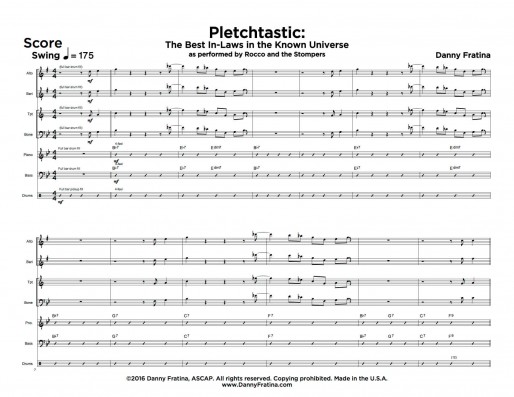 Pletchtastic is a tongue-in-cheek titled song commissioned for Club Drosselmeyer. A simple Bb blues riff melody, solos for every instrument, no backgrounds, and a big intro and ending makes this a great opener, closer, or mid-set rest piece for your horns.
Pletchtastic is a tongue-in-cheek titled song commissioned for Club Drosselmeyer. A simple Bb blues riff melody, solos for every instrument, no backgrounds, and a big intro and ending makes this a great opener, closer, or mid-set rest piece for your horns.Instrumentation Ellington 7-Piece Style Swing Era Level 2 TEMPO  = 175
= 175Trumpet
Range
-
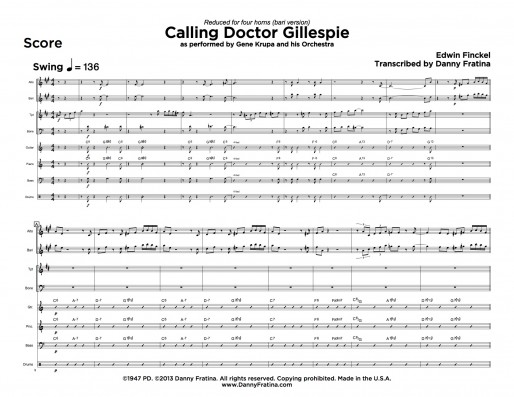 This Edwin Finckel rarity swings hard and doesn't shy away from its bebop influences. Straddling the line between the two eras of jazz, Calling Doctor Gillespie features some infectious melodies and singable shout choruses. A couple of solos in the middle round this out.
This Edwin Finckel rarity swings hard and doesn't shy away from its bebop influences. Straddling the line between the two eras of jazz, Calling Doctor Gillespie features some infectious melodies and singable shout choruses. A couple of solos in the middle round this out.Instrumentation Ellington 7-Piece Style Swing Era Level 3 TEMPO  = 136
= 136Trumpet
Range
-
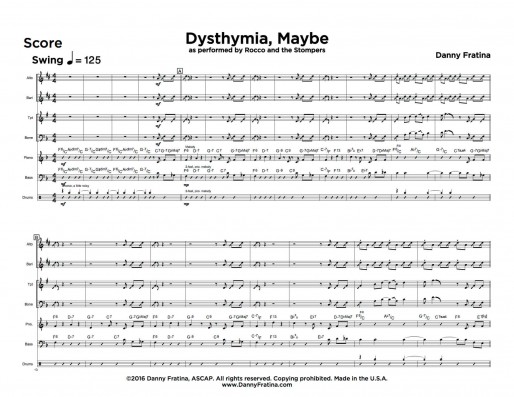 Dysthymia, Maybe is an easy walkin' tune featuring a simplified bluesy unison riff for the melody and easy solo changes in F. This is an easy head tune that gives your horns a nice break while keeping dancers on the floor.
Dysthymia, Maybe is an easy walkin' tune featuring a simplified bluesy unison riff for the melody and easy solo changes in F. This is an easy head tune that gives your horns a nice break while keeping dancers on the floor.Instrumentation Ellington 7-Piece Style Swing Era Level 2 TEMPO  = 125
= 125Trumpet
Range
-
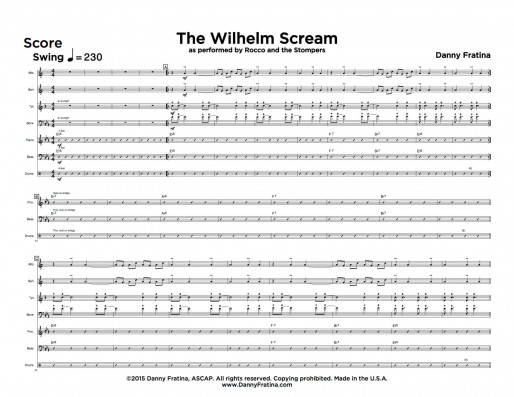 The Wilhelm Scream is a flag waving jam session tune in the spirit of a Basie-style Lester Leaps In or a Shaw-style Diga Diga Doo that is open for solos for any/all instruments in the band. Built modularly, there are unique horn backgrounds that can be played depending on which instrument is soloing, with a final cued shout chorus that brings the house down!
The Wilhelm Scream is a flag waving jam session tune in the spirit of a Basie-style Lester Leaps In or a Shaw-style Diga Diga Doo that is open for solos for any/all instruments in the band. Built modularly, there are unique horn backgrounds that can be played depending on which instrument is soloing, with a final cued shout chorus that brings the house down!Instrumentation Ellington 7-Piece Style Swing Era Level 3 TEMPO  = 230
= 230Trumpet
Range
-
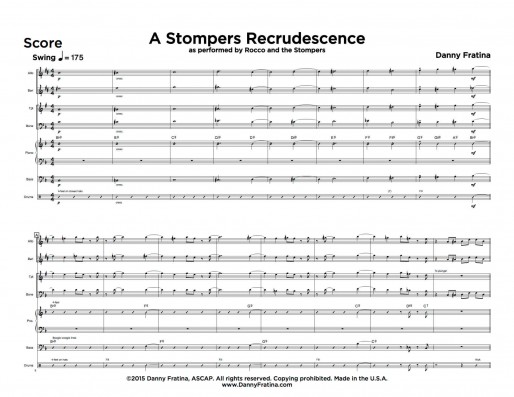 A Stompers Recrudescence is a killer finale piece. It starts with a windup intro, like a train leaving the station, before hitting a pre-head fanfare, then goes on to features all four horn players, an infectious blues head, and a huge final two choruses.
A Stompers Recrudescence is a killer finale piece. It starts with a windup intro, like a train leaving the station, before hitting a pre-head fanfare, then goes on to features all four horn players, an infectious blues head, and a huge final two choruses.Instrumentation Ellington 7-Piece Style Swing Era Level 3 TEMPO  = 175
= 175Trumpet
Range
Solo Instrument: Bari
INSTRUMENTATION
STYLE
DIFFICULTY
VOCALS
PERFORMER
